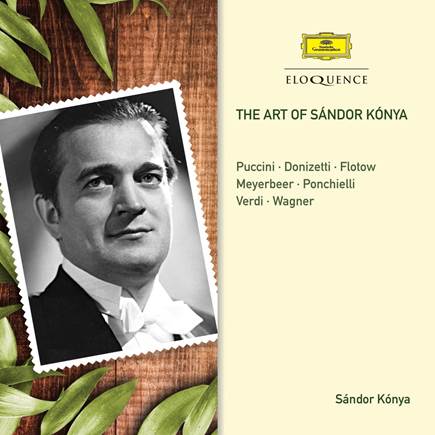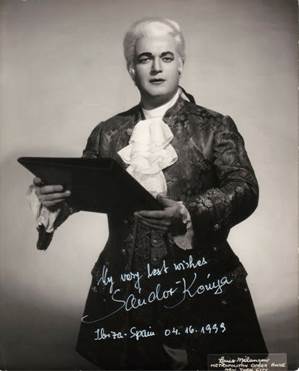
THE ART OF SANDOR KONYA

Sleeve note writer Tony Locantro notes that “apart from participating in a recording of Die Fledermaus that RCA made in 1963 with the forces of the Vienna State Opera under Oscar Danon, Konya otherwise only made three solo recital albums for DG and American Decca/MCA that are presented here. “ Did he really ? Luckily for us he didn’t. Mr. Locantro forgets to mention Konya’s fabulous operetta recital on Polydor; the popular branch of Deutsche Grammophon. At the time –late fifties, early sixties- it was so popular that arias often were broadcasted during pop and sports reports on radio. Then there are several 45 T. with schlager songs as well. And has anyone forgotten the many LP’s of operetta selections (too often in Kurzfassung) on Polydor (Das Land des Lächelns, Paganini, Ein Walzertraum, Victoria und ihr Husar, Der Bettelstudent, Gasparone, Die Fledermaus, Der Zigeunerbaron, Wierner Blut etc.) ? Not that he was exclusively an operetta tenor. On the contrary. Those were the days when the Bundesrepublik frantically rebuilt the devastated country and “Das Wirtschafswunder” (the economic miracle) rapidly restored wealth to West-Germany. Still, some of the older traditions lingered on and for the last time some of the bread and butter operas were recorded in the vernacular. With Konya Deutsche Gramophon had the ideal tenor under contract: a singer whose voice and style sounded purely Italian and who had been living in Germany for many years and spoke the language perfectly. Thus the company recorded him in complete versions of Bohème (with Lorengar, Fischer-Dieskau), Tosca (with Woytowicz), Butterfly (with Schlemm). And then there were a lot of German sung selections on the same label (Nabucco, Contes d’Hoffmann, Aida, Il Trovatore etc. There was even a My Fair Lady). In short at the time -as I remember well- Konya was the most popular tenor in the German language sphere, easily superseding Rudolf Schock, Josef Traxel and Fritz Wunderlich. And then -indeed Mr. Locarno is correct- his recording career almost suddenly came to a halt. I have only one explanation for it. In 1960 Konya started his American career with Fanciulla in San Francisco and next year he went to the Met where he would spent most of his time during the next thirteen years. But now his rivals were no longer Schock and Wunderlich but Corelli, Bergonzi, Tucker, Gedda, Vickers. They were an intimidating bunch and Konya – probably happy with the mighty dollar – nevertheless didn’t t quite belong to the same level. Moreover he cut short his European, especially his German performances. As a consequence he went out of the picture while in the US the competition was overwhelming. Still Met audiences were happy with him (287 performances) but he belonged to the category of Labo, Peerce, McCracken, Prevedi while soon Kraus, Domingo, Pavarotti and Aragall arrived. On the German homefront the days of recording in German were over too and DG started its famous collaboration with La Scala. Tenor roles went mostly to the internationally better known Carlo Bergonzi. Nevertheless Konya remained in the heart and the memories of tenor lovers; witness the double LP and two CD albums of live recordings devoted to his art on Melodram and Gala. His famous official Puccini album was re-issued as well and widely available and now it is once more with us as the first part of CD 1.

 (all photos courtesy Charles Mintzer)
(all photos courtesy Charles Mintzer)
At the time this recital appeared in 1962 it was received with somewhat mixed feelings: passionately appreciated by tenor fans though not by some critics. Hope-Wallace in The Gramophone wrote that if he didn’t know better he would always have thought Konya was an Italian tenor due to his somewhat coarse style, marked by obtrusive sobbing. It is true there always was a tear in the voice but most of us loved Konya for it. The sound was opulent and still slender and truly Mediterranean (his countryman Robert Ilosfalvy showed the same qualities). The high-lying voice of Konya gave the impression he was another shameless top note hunter but people who heard him in the flesh tell me there were a few small spots on his vocal armoury. In the passaggio the sound would become somewhat restricted and thinned out before it once more started to blossom on A and B flat. B natural and high C never came easily to him as is clearly proven by his “Che gelida manina” where he attacks the note in two steps. In “Guardate pazzo son” he improves on Puccini by interpolating the famous “Manooooon-cry” first introduced by that other great composer Beniamino Gigli and since then often repeated in live performances by successors like Bergonzi or Domingo whom I heard doing it (with great acclaim) in Verona in 1970. Konya was the first postwar tenor to record Rinuccio’s “Firenze è come un albero fiorito” on a recital disc and the version is youthful and spontaneous and has in my opinion never been bettered. Youthful and still manly are indeed the first words that people use who hear this recital for the first time. This is not the dramatic sound in Fanciulla we remember from Franco Corelli or Mario Del Monaco but still Konya’s gorgeous timbre compensates for a lack of a few decibels. The sound of the recording and of the orchestra well led by Antonino Votto is still state of the art and notwithstanding some small carping this remains one of the greatest tenor recitals recorded during the New Golden Age of Singing. Typically (and new at the time) for the golden sixties (when labour was somewhat cheaper) is the fact that every note in the score by other voices (Liu, Timur, Sharpless, even the chorus in Turandot) is recorded here as well.

The second part of the first CD is devoted to part of the tracks recorded in 1959, before his American début. Once upon a time they appeared on several MP recordings and then were compiled on LP as Sandor Konya singt Opernarien. Several arias from Italian operas (Rigoletto, Il Trovatore) were still recorded in German but with Konya’s Italian sound one barely notices the language. They are sung straightforwardly by a tenor who goes for a brilliant and beautiful sound. One need not search for deeper insight and some weaknesses are obvious. There is no trill in “Ah si ben mio” and “Di quella pira” is lowered a half tone and finishes with a fine “ahooo”; not a word to be found in either the original or the German language score. Four arias were recorded in Italian (Vasco da Gama’s aria too as it was not very popular at the time in French). Konya is at his best in “Cielo e mar” where his forward tone and passionate delivery suit the music. No trill in “Una furtive lagrima” and once more a little bit strain on the top B in “Celeste Aida”. For a reason unknown to me the Wagner part of that first LP recital is put at the end of the second CD. These arias from Meistersinger and Lohengrin are part of Konya’s greatest heritage. Indeed, I’ve never succeeded in fully appreciating other tenors in those aria’s. Konya’s versions are extremely poetic and sunny and I’m sure Wagner himself would have left his seat to applause had he heard this charmer. Mr. Locantro quotes the late Harold Rosenthal who thought Konya the best Lohengrin since Franz Völker but in my opinion the thick sounding older tenor is no match for the Hungarian tenor. Even stranger in historical hindsight is Andrew Porter’s opinion that Sandor Konya “now has a tone remarkably like that of Jon Vickers”. I wonder how even then one could think Konya’s Italianate voice resembled the Canadian’s beefy leathery delivery; a serious case of jingoism by Mr. Porter. Probably, the nearest a later tenor comes to Konya’s poetry is Kaufmann’s recent recording though the throaty sometimes downright ugly sound from the German tenor lacks the Hungarian’s silver. The first part of the second CD under review is a re-issue from Konya’s last recital album with Verdi and Wagner songs dating from 1967. I remember well that one of my aims during the first of my Manhattan trips consisted in hunting that recording which I had never met in Europe. I succeeded at my first trial in 1985 as those were the days a good classical second hand shop could still find space on Broadway (later on Gryphons moved to 72 nd Street West before it closed). However I have to admit that Konya is not at his most convincing. Of course fault is to be found with the songs themselves; not Verdi’s greatest offerings (Wagner is marginally more inspiring). Bergonzi for example succeeds better in making the songs come alive. Konya is hampered by the piano and by the fact that he has to restrain himself; that he cannot tear at them with teeth and claws and some awe-inspiring sobs and thus his sound loses its lusciousness. Nevertheless this 2 CD album is highly recommended to collectors who don’t have the original LP’s or to younger people for whom the name is only vaguely familiar. Deutsche Grammophon would do well to devote another issue to the lighter side of Sandor Konya. The operetta recital, the 45 T’s which never appeared on LP, the radio recordings of popular songs plus some arias from his operetta selections would make a wonderful addition. And what a pity it was that a complete Paganini was recorded by him and shown on television while an actor played his part.
Click here to read more about Sandor Konya and his recorded legacy
Jan Neckers, June 2014